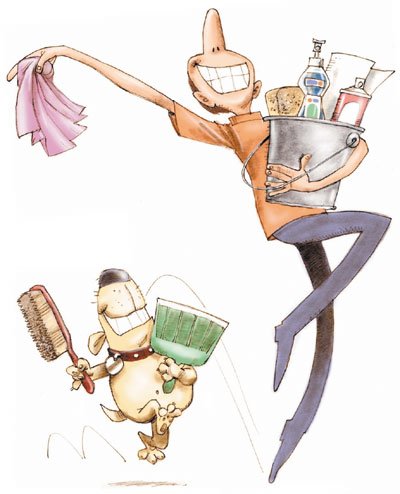In this age of clean-burning fuels, vacuum cleaners and
Scotchgard, you’d think the house-scouring ritual of spring
cleaning would have been left in the dust. Yet it hangs on as
tenaciously as grime to a miniblind.
In this age of clean-burning fuels, vacuum cleaners and Scotchgard, you’d think the house-scouring ritual of spring cleaning would have been left in the dust. Yet it hangs on as tenaciously as grime to a miniblind.
More than three-quarters of Americans still engage in spring cleaning, according to a survey by the Soap and Detergent Association. That surprised the association, which expected the figure to be a little lower, spokesman Brian Sansoni said.
Nevertheless, he thinks he understands why.
“Springtime evokes freshness, getting outdoors, being active after being cooped up all
-winter,” Sansoni said. “You want to open the windows. You want your whole house or apartment
to be fresh.”
If the practice of spring cleaning hasn’t changed much, the way we approach it has. Cleaning products work more effectively and efficiently than ever. More homeowners have the means to hire out the big jobs. And couples are more likely to share the work rather than relegating it to the woman of the house, said Linda Hallam, editor of the Better Homes and Gardens book “Making a Home: Housekeeping for Real Life.”
Hallam does her seasonal cleaning with her husband, and she likes the renewal associated with it. Especially in areas with cold winters, where houses are closed up for months, people seem to enjoy greeting spring with a thorough cleaning and freshening, she said.
Still, that doesn’t mean you have to clean the house from top to bottom just because the calendar says you should, said Jeff Campbell, owner of a San Francisco cleaning company called The Clean Team and author of the book “Spring Cleaning.” He advocates cleaning as it’s needed instead, and defines spring cleaning as “the stuff that you don’t do every week but that you can’t ignore forever” – big chores like cleaning windows and walls, stripping floors, cleaning carpets and polishing metals.
“There’s something about a clean house, a clean room,” Sansoni said. “It does wonders for the psyche.”
So, you think your psyche could use a lift? Then dive right in – but don’t grab the Pine-Sol and the sponge mop just yet. You’ll get a lot more done with less energy if you plan your cleaning strategy, the experts said.
Hallam’s book recommends making the rounds of your house, inside and out, and jotting down every project that needs to be done. Write those chores on three sheets of paper, one for large projects that require a half-day or more, one for projects that require two to three hours, and one for small projects. Then prioritize the projects according to what needs to be done most – or, as Campbell suggested, what makes you the craziest. Succeeding at the most odious task will motivate you to tackle others, he said.
Once you’ve decided what you’re going to do, make a list of the cleaning supplies you need, the association suggested. When you make your regular trip to the grocery store or drugstore, stock up.
But before you even pick up a dust rag, cleaning experts recommend getting rid of clutter and organizing the house. Give away, sell or throw away anything you no longer need. If you’re not sure, Ward suggested asking yourself three questions: “When did I use it last?” “Do I really need it?” and “Where will I put it?”
If you’re still not sure, box the stuff up and seal the carton. After a year, pitch the whole thing if you haven’t opened it yet, cleaning-company
owner and author Schar Ward said.
When it’s time to start cleaning, the experts recommend limiting your steps by finishing an entire room and an entire floor before moving on. Take all your supplies with you, so you don’t have to make extra trips back and forth or up and down stairs.
Cleaning the whole house will be exercise enough. But just think how good you’ll feel when it’s done.
The right supplies
Cleaning pros typically recommend carrying most of your supplies with you, which means you need something to carry them in. Some prefer an apron designed to hold cleaning implements, similar to a tool belt. Others prefer a plastic bucket or a caddy with a handle.
The pros also differ somewhat about which cleaning supplies should be put in that carrier, but these are commonly recommended:
– All-purpose cleaner.
– Glass cleaner.
– Nonabrasive cleanser for the bathroom.
– Disinfectant cleaner.
– Sponge.
– Cleaning cloths (heavy-duty cloths for floors and lightweight ones for dusting).
n Old toothbrush.
In addition to the things you carry with you, you’ll need supplies for bigger jobs, such as a bucket, a mop (if you don’t want to wash floors on your hands and knees), a squeegee for windows and either a vacuum cleaner with attachments or an upright vacuum and a separate portable vacuum with attachments. Other nice-to-have items are a lamb’s wool duster on a telescopic pole, a plastic spatula or other scraping tool, a safety razor in a holder for scraping off really stubborn gunk, oil soap, a nylon scrubber, a whisk broom and a dustpan.
Even if you carry your supplies in a tote, wear an apron with pockets while you clean. It’ll give you a place to stash the things you pick up as you go.
10 chores to do
Take care of these 10 cleaning chores and you’ll give your house a fresh start for the warm season.
1. Wash windows: Clean storm windows before you store them for the summer, and don’t forget to clean screens before you install them.
2. Freshen bedding: Strip the beds and launder all the washable bedding, including blankets, mattress pads and pillow protectors. Dry clean the things that can’t be washed. Freshen pillows by having them professionally cleaned, hanging them outside or tumbling them in the clothes dryer on the air cycle.
3. Clean window treatments: Launder washable curtains, or just tumble them in the dryer to freshen them. Vacuum nonwashable draperies with an upholstery brush, or have them cleaned. Clean blinds and shutters (disposable wipes that fit over a hand are useful for this), or take down blinds and wash them.
4. Clean carpets, rugs and floors: Launder washable throw rugs, and have the other rugs professionally cleaned. Clean hard floors using the best method for the finish.
5. Clean light fixtures and ceiling fans: Remove and wash glass globes. Wipe light bulbs with a damp cloth, then dry. If a bulb has burned out in a hard-to-reach chandelier, change all the bulbs at the same time because the others probably are about to burn out, too.
6. Declutter closets and storage areas: Sort out the things you no longer want and the items that don’t belong. Store winter tools such as shovels and scrapers, and store out-of-season clothing after attending to garments that need to be cleaned or repaired. Bring out spring clothes and seasonal equipment. Sweep garage and shed floors.
7. Wash baseboards: Use a household cleaner and water for painted baseboards. For wood baseboards, use a cleaner designed for wood, such as oil soap. Wipe in the direction of the grain and dry immediately.
8. Clean vents and refrigerator coils: Remove the grilles from heating and cooling vents so you can vacuum the vent openings. Clean lint from the dryer vent and the pipe leading to the outside. Vacuum refrigerator coils.
9. Declutter and wipe out cabinets, drawers: Get rid of equipment you don’t use, and store seldom-used items in less accessible spots. Pitch stale spices, outdated food and old medications.
10. Spot-clean or wash walls: Take everything off the walls, then dust or vacuum the ceilings and walls. Remove spots with all-purpose cleaner and water, or by gently rubbing on a thick paste of baking soda and water with a cloth or sponge. (Test in an inconspicuous place first.) Use a commercial putty cleaner to remove spots from nonwashable wallpaper. If necessary, most painted walls can be washed with an all-purpose cleaner or ammonia and water. Walls covered in flat paint, however, often can’t be washed successfully.














